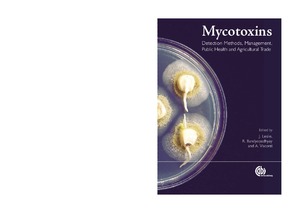| dc.contributor.author | Menkir, A. |
| dc.contributor.author | Brown, R.L. |
| dc.contributor.author | Bandyopadhyay, Ranajit |
| dc.contributor.author | Chen, Z.Y. |
| dc.contributor.author | Cleveland, T.E. |
| dc.date.accessioned | 2019-12-04T11:14:32Z |
| dc.date.available | 2019-12-04T11:14:32Z |
| dc.date.issued | 2008 |
| dc.identifier.citation | Menkir, A., Brown, R.L., Bandyopadhyay, R., Chen, Z.Y. & Cleveland, T.E. (2008). Breeding maize for resistance to mycotoxins at IITA. In J.F. Leslie, R. Bandyopadhyay and A. Viscont, Mycotoxins: detection methods, management, public health and agricultural trade, (p. 277-286). Wallingford: CAB International. |
| dc.identifier.isbn | 978-1-84593-082-0 |
| dc.identifier.uri | https://hdl.handle.net/20.500.12478/2789 |
| dc.description.abstract | Ear-rot-causing fungi, including Aspergillus and Fusarium spp., are common in maize in West and Central Africa. These fungi contaminate maize with mycotoxins that pose serious potential health hazards to humans in these areas. A collaborative germplasm screening project was initiated between the International Institute of Tropical Agriculture (IITA) and the Southern Regional Research Center (SRRC) of the USDA's Agricultural Research Service in 1998 to develop maize germplasm with resistance to aflatoxin contamination. In a laboratory screen, some IITA inbred lines had potential levels of resistance to aflatoxin production as high as or higher than the best lines from the United States. These results prompted the initiation of a breeding project to combine resistance factors from the IITA lines with resistance factors from the US inbred lines. Several crosses and backcross populations were made from selected resistant or potentially resistant inbred lines from the US and IITA. Sixty-five S5 lines were developed from the backcross populations and 144 S5 lines were derived from the F1 crosses. Kernels from these lines were screened in a laboratory assay. Significant differences in aflatoxin accumulation were detected amongst the lines within each group. Several S5 lines in which aflatoxin contamination was significantly less than in either parent were selected for resistance-confirmation tests. We found pairs of S5 lines with 88-97% common genetic backgrounds that differed significantly in aflatoxin accumulation. These pairs of lines are being used for proteomic analyses to identify the proteins and the corresponding genes that limit aflatoxin accumulation. We also found significant differences in fumonisin accumulation amongst 58 elite maize inbred lines in which variation in aflatoxin accumulation was found. Both the new inbreds and the elite lines can be exploited as new genetic sources in breeding programs in which the objective is to develop maize cultivars/hybrids that accumulate lesser amounts of mycotoxins. |
| dc.description.sponsorship | European Union |
| dc.language.iso | en |
| dc.subject | Disease Resistance |
| dc.subject | Fungal Diseases |
| dc.subject | Maize |
| dc.subject | Mycotoxins |
| dc.subject | Microbial Contamination |
| dc.subject | Pathogens |
| dc.subject | Breeding |
| dc.title | Breeding maize for resistance to mycotoxins at IITA |
| dc.type | Book Chapter |
| dc.description.version | Peer Review |
| cg.contributor.affiliation | International Institute of Tropical Agriculture |
| cg.contributor.affiliation | Johns Hopkins University |
| cg.coverage.region | Acp |
| cg.coverage.region | Africa |
| cg.coverage.region | North America |
| cg.coverage.region | West Africa |
| cg.coverage.country | United States |
| cg.coverage.country | Nigeria |
| cg.authorship.types | CGIAR and advanced research institute |
| cg.iitasubject | Plant Diseases |
| cg.iitasubject | Plant Breeding |
| cg.iitasubject | Disease Control |
| cg.iitasubject | Maize |
| cg.iitasubject | Aflatoxin |
| cg.iitasubject | Genetic Improvement |
| cg.accessibilitystatus | Limited Access |
| local.dspaceid | 93890 |
| cg.identifier.doi | http://dx.doi.org/10.1079/9781845930820.0277 |

